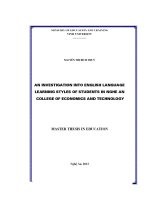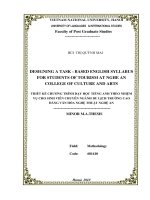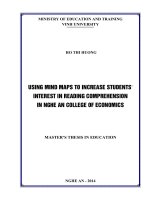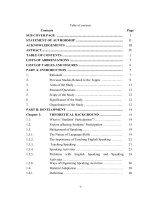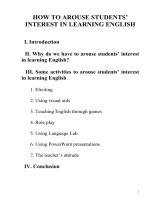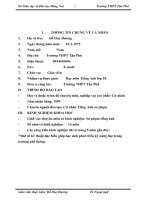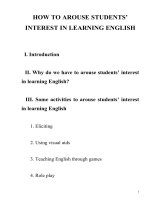Using mind maps to increase students interest in reading comprehension in nghe an college of econmics
Bạn đang xem bản rút gọn của tài liệu. Xem và tải ngay bản đầy đủ của tài liệu tại đây (1.56 MB, 95 trang )
MINISTRY OF EDUCATION AND TRAINING
VINH UNIVERSITY
HO THI HUONG
USING MIND MAPS TO INCREASE STUDENTS’
INTEREST IN READING COMPREHENSION
IN NGHE AN COLLEGE OF ECONOMICS
MASTER’S THESIS IN EDUCATION
NGHE AN - 2014
MINISTRY OF EDUCATION AND TRAINING
VINH UNIVERSITY
HO THI HUONG
USING MIND MAPS TO INCREASE STUDENTS’
INTEREST IN READING COMPREHENSION
IN NGHE AN COLLEGE OF ECONOMICS
Major: Teaching English to Speakers of Other Languages
Code: 60.14.01.11
MASTER’S THESIS IN EDUCATION
Supervisor: Nguyen Gia Viet, Ph.D
Nghe An, 2014
i
DECLARATION
I certify my authority of the paper submitted entitled
USING MIND MAPS TO INCREASE STUDENTS’ INTEREST IN READING
COMPREHENSION IN NGHE AN COLLEGE OF ECONOMICS (NACE).
In total fulfillment of the requirements for the degree of Master of Arts.
Vinh, August 2014
Student’s signature
Hồ Thị Hương
ii
ACKNOWLEDGEMENT
On the completion of this thesis, I would like to express my deepest gratitude
to my supervisor, Ph.D. Nguyen Gia Viet, who gave me precious guidance,
comments, suggestions and encouragement throughout my research.
My special thanks are for all my teachers of my M.A. course (TESOL) at the
Post-graduate Department at Vinh University, Nghe An province, for their
interesting and useful lectures.
I also wish to express my sincere thanks to all my colleagues and the first -
year students at Nghe An College of Economics, for their contribution to the data
collection and their attendance in the reading lessons for this research.
Finally, I am grateful to my friends and my family, especially my husband
who gave me a lot of support and encouragement during the time of my study
iii
ABSTRACT
USING MIND MAPS TO INCREASE STUDENTS’ INTEREST IN
READING COMPREHENSION is a case study about reading comprehension at
Nghe An College of Economics in 2014. The objective of this study is to investigate
if using mind maps can help to encourage students in reading comprehension,
especially for the reading texts in “New Headway” (pre-intermediate) at the first-
year students of Nghe An College of Economics. The subjects of this study were 97
students and 7 teachers in the English group.The study concentrates on answering 3
research questions: Firstly, the researcher wants to investigate students’ and
teacher’s attitudes towards the reading texts in “New Headway” textbooks.
Secondly, the researcher wishes to examine students’ and teacher’s perception about
mind mapping. Thirdly, she hopes to find out if mind mapping technique can help
to increase students’ interest in reading comprehension.To solve these research
questions, the mix-method (both qualitative and quantitative methods) was used in
the study which was carried out in two classes. The data were gathered through
questionnaires and interviews. The two sets of questionnaires were delivered before
the seminar and classroom observation and after that. The interview was carried out
at the same time with the second set of questionnaires. The results of the study
showed that mind mapping technique is effective to be used in teaching reading
comprehension of the reading texts in “New Headway” (pre-intermediate). The
findings of the research revealed that mind mapping technique really helps to
improve students’ interest in reading comprehension.
iv
TABLE OF CONTENTS
Pages
DECLARATION i
ACKNOWLEDGEMENT ii
ABSTRACT iii
TABLE OF CONTENTS iv
LIST OF TABLES vi
LIST OF FIGURES vii
CHAPTER 1. INTRODUCTION 1
1.1. Rationale to the study 1
1.2. Aim of the study 4
1.3. Research questions 4
1.4. Scope of the study 5
1.5. Significance of the study 5
1.6. Methodology 5
1.7. Outline of the thesis 6
CHAPTER 2. THEORETICAL BACKGROUND AND LITERATURE
REVIEW 7
2.1. Definition of reading and reading comprehension 7
2.1.1. Definition of reading 7
2.1.2. Reading comprehension 8
2.1.3. Effective reading comprehension 8
2.2. Teaching reading in the second language learning classroom 9
2.2.1. The importance of teaching reading in the L2 classroom 9
2.2.2. Reading purposes of second language learners 10
2.2.3. Different ways for L2 learners to process a text 10
2.2.4. Teachers’ roles in a reading lesson 10
2.2.5. Students’ roles in a reading lesson 11
2.3. Mind mapping 11
v
2.3.1. The definition of mind mapping 11
2.3.2. Application of mind mapping technique in teaching 12
2.3.3. Benefits of teaching with mind maps 14
2.4. Literature review 14
CHAPTER 3. METHODOLOGY 19
3.1. Context 19
3.1.1. The setting 19
3.1.2. Participants 20
3.2. Instruments for data collection 21
3.3. Data collection procedures 22
3.4. Analysis 23
3.4.1. Questionnaires 23
3.4.2. Interview 24
CHAPTER 4. DATA ANALYSIS AND FINDINGS 25
4.1. Data analysis from the questionnaire 25
4.1.1. For teachers 25
4.1.2. For students 37
4.2. Summary of the questionnaire survey 53
4.3. Data analysis from the interview 54
4.3.1. For students 54
4.3.2. For teachers 57
4.4. Summary of the interview findings 59
CHAPTER 5. CONCLUSIONS AND RECOMMENDATIONS 61
5.1. Introduction 61
5.2. Summary 61
5.3. Limitations and recommendations for further study 61
REFERENCES 63
APPENDICES
vi
LIST OF TABLES
Pages
Table 3.1. Topics and the related reading texts from “New Headway”
(pre-intermediate) 20
Table 4.18. Before and after the seminar and clasroom observation 47
Table 4.19. Students’ views about mind mapping application before and
after seminar when dealing with statement 9. 48
Table 4.20. Before and after the seminar and classroom observation. 49
Table 4.21. Before and after the seminar and classroom observation. 50
Table 4.24. Students’ views on finding ideas from reading texts 54
Table 4.25. Students’ attitudes towards reading comprehension after using
mind mapping 55
Table 4.26. Students’ perceptions about mind mapping technique 55
Table 4.27. Students’ views on the texts after applying mind maps in the
reading lessons. 56
Table 4.28. Students’ attitudes towards the task of preparing their own map
for the text 56
Table 4.29. Students’ attitudes towards the next lessons 57
Table 4.30. Teachers’ ideas about students’ attitudes in reading lessons 57
Table 4.31. Teachers’ views on mind mapping application 58
Table 4.32. Teachers’ views on weak students through the reading lessons
with mind mapping 58
Table 4.33. Teachers’ views on mind mapping 59
vii
LIST OF FIGURES
Pages
Figure 4.1.a. Teachers’ attitudes towards the reading texts in textbook before
seminar and classroom observation. 25
Figure 4.1.b. Teachers’ attitudes towards the reading texts in textbook after
the seminar and classroom observation. 26
Figure 4.2.a. Before students approached mind mapping through seminar and
classroom observation 27
Figure 4.2.b. After students approached mind mapping through seminar and
classroom observation 27
Figure 4.3.a. Before the seminar and classroom observation 28
Figure 4.3.b. After the seminar and classroom observation 29
Figure 4.4.a. Before the seminar and classroom observation 30
Figure 4.4.b. After the seminar and classroom observation 30
Figure 4.6.a. Before the seminar and classroom observation 31
Figure 4.6.b. After the seminar and classroom observation 32
Figure 4.7.a. Before the seminar and classroom observation. 33
Figure 4.7.b. After the seminar and classroom observation 33
Figure 4.8.a. Before the seminar and classroom observation 34
Figure 4.8.b. After the seminar and classroom observation 34
Figure 4.9.a. Before the seminar and classroom observation. 35
Figure 4.9.b. After the seminar and classroom observation. 36
Figure 4.10.a. Before the seminar and classroom observation 36
Figure 4.10.b. After the seminar and classroom observation 37
Figure 4.11.a. Before the seminar and classroom observation. 38
Figure 4.11.b. After the seminar and classroom observation 38
Figure 4.12.a. Before the seminar and classroom observation 39
Figure 4.12.b. After the seminar and classroom observation. 39
Figure 4.13.a. Before the seminar and classroom observation 40
viii
Figure 4.13.b. After the seminar and classroom observation 41
Figure 4.14.a. Before the seminar and classroom observation 41
Figure 4.14.b. After the seminar and classroom observation 42
Figure 4.15.a. Before the seminar and classroom observation 43
Figure 4.15.b. After the seminar and classroom observation. 43
Figure 4.16.a. Before the seminar and classroom observation 44
Figure 4.16.b. After the seminar and classroom observation 45
Figure 4.17.a. Before the seminar and classroom observation 46
Figure 4.17.b. After the seminar and classroom observation. 46
Figure 4.22.a. Before the seminar and classroom observation 51
Figure 4.22.b. After the seminar and classroom observation. 51
Figure 4.23.a. Before the seminar and classroom observation. 52
Figure 4.23.b. After the seminar and classroom observation. 52
1
CHAPTER 1
INTRODUCTION
Reading leads into an ever-expanding multidimensional world and the reader
is to widen his knowledge through reading. The importance of reading
comprehension has increasingly been recognized and that helps a lot in learning
different fields. The researcher is going to examine if using mind mapping helps to
increase students’ interest in learning reading comprehension. This chapter includes
the rationale to the study, the aim, the scope, the research questions, the significance
of the research, the methodology, and the design of the study.
1.1. Rationale to the study
The researcher intends to discover the effect of using mind mapping technique in
increasing students’ interest in reading comprehension because of several reasons.
At present, reading is a compulsory skill in all schools and vocational trainings
in Vietnam. The English language curriculum for colleges and universities is based
on the four language skills. They are listening, speaking, reading and writing which
are the cores of the curriculum. Learners use these skills to communicate with
people, obtain information and present information, respond to the literary texts and
express themselves creatively According to Carrell (1984:1), reading is considered
as one of the most important of the four macro skills, especially for students
learning English as the second language. Becoming an effective and good reader in
anothet language, a reader can consolidate their already-learning knowledge. Then,
the reading process in foreign language may help students to review as well as
increase their knowledge of the target language through exposure to new vocabulary
and grammar structure in the text. The English Language Curriculum (2000) stated
that reading a lot of texts will enable learners to adjust the speed and style of their
reading to suit the purpose and to extract both implicit and explicit meaning from
the text. Therefore, reading skill is still one of the most important aspects to be
taught in the colleges and universities in order to enable the students to grasp the
meaning from the reading text.
2
Moreover, students are now expected to read difficult texts as they move to
higher forms. The texts are found more complex and difficult for them to
comprehend as they move from one level to another. Most of the texts require
learners’ thought and individual construction of meaning. Nowadays, the texts
contain various subject matters which challenge the reader to understand the text.
The texts that are read by the learners at the present are more diverse than those
used several decades ago. Formerly, reading skill was taught for the instructional
purpose and learners are only exposed to narrative, expository and descriptive
genres. Whereas, these days students are expected to read a variety of text which
differ in content and readability. These varieties of text make it much more difficult
for the learners to read and comprehend. And they gradually find it bored to read
the difficult texts, even the reading comprehension parts in the textbooks.
In order to solve the problem of students’ interest in the reading parts in the
textbooks, the researcher conduct the project of using mind mapping to make the
students more interested in the reading comprehesion skill and more specifically in
the reading parts in the textbook: “New Headway”-Pre-intermediate (3
rd
ed). The
researcher hopes the result of this project will give some success in improving
students’ attitude as well as performance to the reading comprehension skill.
In the context of Nghe An college of economics (NACE), English is being
divided into two categories: the first one is basic English for first-year students with
the textbook “New Headway”, pre-intermediate (third edition). The second one is
English for special purposes (ESP) for second-year accounting students. They are
all compulsory subjects in the college and they are always taught in the first year
and the second year of the course. However, the results of the final examinations
showed that the students can not master most of the knowledge that their teachers
provided them. Only 20 percents of them got good marks of seven, eight and nine.
Hardly did they have the mark of ten. The rest of students just got the average mark
that is enough for them to pass the examination.
Over the past seven years of teaching in the college, the researcher realized
that most of the students are weak on reading comprehension skill. Their reading
3
process includes reading, translating, looking up the new words, then translating the
tasks in the texts, and after that doing the tasks. It usually takes them more than 60
minutes to read one text in reading parts of the textbook “New Headway”.
Furthermore, students are not very patient. So, they may not follow the text from the
beginning to the end because they feel bored with the texts. In fact, the students in
NACE have not really understood the purposes of reading comprehension. Despite
the teachers’ efforts, most students’ motivation for intensive reading is still low.
Therefore, they always consider the reading lessons the most boring ones in English.
Most of the students here do not have adequate reading comprehension skill to
do what is expected of them.Without comprehension, reading is simply following
words on a page from left to right while sounding them out. The words on the page
have no meaning. And while people read for many different reasons, the chief goal
is to derive some understanding of what the writer is trying to convey and make use
of that information, whether the fact gathering learning a new skill, or for pleasure.
That’s why reading comprehension skill is so important. Without it, learners can not
gather any information and use it to enjoy the richness of life.
There are several reasons why students are weak on reading comprehension.
In their study, Arbaiyah and Zaidah (2001) discovered that students are bad at
reading skill because they lack of independent reading. In comparision with skilled
students, the ones in NCE read less because they are not very fond of doing this
task. The second reason is the method that teachers use to teach students. David
Hayes, (1989) in his research stated that there are some teachers who have just
graduated from training colleges and some others who have been working in
schools for many years seem to follow the teachers’ books correctly. They are
completely dependent on what the head teachers, the school supervisors or the
inspectors guide. Their teaching style is heavily teacher-centered and many of the
activities in their classroom are focused on rote learning. Their lessons are boring
and lack of creativity. That makes students bored with learning. This teaching style
is not appropriate for teaching reading. Students don’t feel happy to read the texts.
4
This case is exact in Nghe an College of Economics. The students here do not have
really interesting reading lessons because they are not interested in reading. Real
learning takes place when the students in a natural setting take part in activities that
require them to use what they have learnt.
Moreover, the knowledge around the world is so big and is written in English.
The best and cheapest way to get this knowledge is reading. However, it is
impossible to have this background knowledge if students are not interested in
reading comprehension. The reading task will be postponed or stopped unless you
find reading really interesting. The teachers’ duty is gradually creating students’
interest in reading texts. When they find the texts , the articles or the books
interesting, they will try their best to fulfil them. Therefore, they can get more
understanding about the world.
There are a lot of ways to motivate students to read such as using games,
cards, pictures or developing pre-reading stage, while-reading stage or post-reading
stage Using mind maps to increase students’ interest is still a question that the
reseacher is going to study.
With the real situation of teaching and learning in Nghe an College of
Economics, the researcher is going to do this study with the hopes to give some
important contributions to improve the quality of teaching and learning in NCE.
1.2. Aim of the study
The aim of the research is to examine if using mind mapping helps to increase
students’ interest in reading comprehension skill.It aimes at:
1. Identifying students’ perceptions about mind mapping and using mind
mapping in reading comprehension.
2. Examining the effect of using mind mapping on students’ interest in reading skill.
1.3. Research questions
The study aims to answering the following questions:
1. What are the students’ attitudes to the reading comprehension texts in the
textbook?
5
2. What are the students’ and the teachers’ perceptions towards mind mapping
in reading comprehension?
3. Does using mind mapping help to increase students’ interest in reading
comprehension?
1.4. Scope of the study
The researcher carries out the investigation at Nghe An College of Economics
to study the result of mind mapping in reading activities to improve the students’
interest and help them to read better.
1.5. Significance of the study
This research attempts to examine whether mind mapping will improve
students’ interest in reading comprehension. Reading will be the most important
aspect in acquiring the target language. Reading comprehension will be the premier
skill in the English Curriculum in the colleges and universities. Mind mapping
strategy will help to increase students’ interest in reading comprehension.
Therefore, the result of this study will prove that mind mapping technique will
make students more interested in reading comprehension. It will help the readers to
verify the strategy to be used and the adjustment can be made when students
comprehend the text. In addition, this strategy will help teahers to improve their
teaching methodology and increase students’ performance in reading
comprehension. The findings of the study will lead to the strategy to improve
classroom’s atmostphere in reading periods.
In sum, this study is significant because it helps to improve the classroom’s
atmosphere in reading lessons. Besides that, this study significantly contributes to
the reading strategy and gives some insights to teachers and learners.
1.6. Methodology
To fulfil this study, a mixed use of both qualitative and quantitative methods
are applied. The data are collected by means of questionnaire and interview.
This research was carried out through a number of procedures: pre-
questionnaires, seminar and mind mapping application in the classroom, post-
6
questionnaires, and interviews with teachers and students. Details will be presented
in Chapter Three.
1.7. Outline of the thesis
The thesis will be divided into five chapters:
The present chapter presents rationales as to why this study should be carried
out, aims, research questions, scope, and the significance of the study.
Chapter Two, entitled “Theoretical background and literature review”,
provides the definition of reading and reading comprehension, mind mapping and
literature review.
In Chapter Three, Methodology, the researcher describes the setting,
participants, instruments for data collection, data collection procedures and
analysis.
Chapter Four, named “Data analysis and Findings”, offers the data analysis
from the questionnaires and interviews for both teachers and students.
Chapter Five, “Conclusion”, is a review of the study, the limitations of the
study and recommendations for further research.
7
CHAPTER 2
THEORETICAL BACKGROUND AND LITERATURE REVIEW
2.1. Definition of reading and reading comprehension
2.1.1. Definition of reading
According to Rumelhart’s study in 1984, reading activity involves the reader,
the text and the interaction between the reader and the text. Therefore learners and
reading texts play very important roles in reading acts. This statement supported the
one in Goodman’s study (1967) considering reading as a process in which the
reader tries his best to reconstruct the message encoded by the writer.
Ur in his simple definition about reading stated that: “reading means reading
and understanding” . Harmer seemed to be interested in the notion of reading. He
introduced to the world, in his study (1989:190), a different view on study. In his
point of view, reading is a process created by both the eyes and the brain. He
explained that in this process, the eyes are responsible for writing the message and
then it’s the brain’s duty to write out the meanings of the message.
Moreover, Rubin,J. and Thompson,I. (1994:91) offered another definition of
reading. According to their points of view, “reading is an active information-
seeking process in which readers relate information in the text to what they already
know”. From this view, the reader’s knowledge of the language and knowledge of
the world is of importance to their reading success.
Although there have been a lot of definitions, the act of reading is not
completely easy to be described. Many definitions have been drawn from different
reading theories by various scholars. All of them are trying to find out the nature of
reading and reading acts, in which the readers, reading process and reading message
are emphasized.
This study employs the definition prescribed by Rumelhart in that reading is a
process in which there happens the correlation between the reader and the text. If
the reader acts well, this process of reading will be effective. In this point of view, it
8
can be seen clearly that teacher must think of a technique that can help the reader to
do his or her task successfully. And the technique being experimented in this study
is mind mapping that is created by Tony Buzan in 1960.
2.1.2. Reading comprehension
Reading comprehension plays an important role in teaching and learning a
foreign language. It can be known as the ability to get the information required in
the reading text as effeciently as possible.
Reading can be affected by world knowledge, with many demonstrations that
readers who possess rich prior knowledge about the topic of a reading often
understand the reading better than classmaates with low prior knowledge. As Roe,
Stood and Burns (1987:2) mentioned in their study, reading comprehension is the
process of reconstructing, interpreting and evaluating the author’s meanings in the
text by using knowledge from everyday life.
Anderson and Pearson (1984:255) believed that when students make a critical
evaluation of the ideas mentioned in the text, “they are making connection between
the new information on the printed page and their existing knowledge”.
Swans stated in his study in 1975 that a student is said to be good at
comprehension if “he can read accurately and efficiently, so as to get the maximum
information of a text. Then in 1981, Grillet mentioned to comprehension as
understanding a written text. He confirmed that those two processes are receiving
required information in the text as efficiently as possible.
Despite different opinions, they all have a common point of view, that is
reading comprehension is the process in which the readers, as they read, can
recognize the graphic forms of the reading text and can understand what is implied
behind these forms.
2.1.3. Effective reading comprehension
As we know that in reading comprehension, comprehension is the reason for
comprehension. In the National Reading Panel (2000), the reporter considered
comprehension as the complex cognitive processes involving the intentional
interaction between the reader and the text to the meaning.
9
In the traditional method, teachers expected their students to read a lot of texts
which are different about contents and readability. Students do not feel interested in
what they are reading.They do not integrate with the texts. The teaching method is
traditionally teacher-centered and most of classroom activities deal with rote
learning. In the traditional method, students have inefficient stategies and use them
inflexibly during the reading process. They are unaware of what good
comprehenders should do and need to do when approaching a piece of text. As
Yorio synthesized in 1971 that awareness and control of one’s reading activity and
the ability to monitor one’s own comprehension are very important. In fact,
teaching reading has been given enough care in Nghe An College of Economics.
Students are not taught how to learn as well as how to read the texts efficiently
meanwhile the most important thing of learning depends on student’s own ability to
organise and structure information into memory. The weaker comprehenders with
low ability in reading comprehension can not reorganize the information learnt
from the text and can not connect their own knowledge to the new information
received from the reading text. Such reading processes cause students lack of
motivation to read. One of the teacher’s duties is looking for new and modern
technique to help students to improve reading comprehension. The researcher has
been thinking and studying for a long time about the solution to increase students’
interest in reading comprehension. And using mind maps is the technique that the
researcher is trying to experiment to have the final conclusion.
2.2. Teaching reading in the second language learning classroom
2.2.1. The importance of teaching reading in the L2 classroom
In a second classroom, reading plays a significant role in building both
linguistic and background knowledge for other language skills.Hoang et al
(2006a:191) consider reading as the most effective means of improving students’
language competence. Especially, when there is a lack of L2 environment, reading
is even more significant since it helps enlarge students’ background knowledge and
vocabulary as well as support other skills (Hoang et al. , 2006b).
10
2.2.2. Reading purposes of second language learners
In their study, Rivers and Temperley assumed that there are some purposes for
the second language learners read in that languauge: Firstly, they read because they
want to get information for some purposes or may be because they are curious
about that topic. Secondly, They want to have experiences in performing some tasks
in their work or their daily life. Thirdly, they read documents because they want to
keep in touch with friends by correspondence or to understand business letters.
Then, when they are interested in what and where something will take place, what
is available or what is happening and has happened, they must read. Lastly, they
read in order to fulfil their enjoyment or excitement (Rivers and Temperley, 1978).
2.2.3. Different ways for L2 learners to process a text
Nuttall (1996) introduced two main ways for a reader to process a text. The
first one is bottom-up approach in which readers try to understand the text
themselves by recognizing the letters and words and finding out the meanings of the text
from the sentence structures. In the second approach, the top-down one, the readers must
consider their intelligence and experience as the means for comprehending the reading
text. However, in some recent studies, two approaches have been encouraged to be
combined in order that the readers will have effecient reading.
2.2.4. Teachers’ roles in a reading lesson
Linguistists recently have mentioned to many teaching reading approaches
such as the traditional approach, process-based approach and task-based approach
(Hoang et al, 2006a:517). All these approaches believed that the roles of teachers in
a reading lesson are very important.
On the other hand, in Nuttall’s views (2002), teachers are responsible for
choosing the reading texts, designing tasks, facilitating reading process and
monitoring learning progress. As a result, the teachers have a lot of things to do in a
reading lesson. However, Nuttall reminds most of teachers to avoid some mistakes
in teaching reading in which their over-dominant role is one of the serious
mistakes.
To sum up this view, Anderson (2003) and Hedge (2000) listed six major
principles of teaching reading in the classroom. Firstly, teachers must exploit
11
students’ background knowledge. Secondly, teachers try to build a strong
vocabulary base. Then, they are responsible for teaching comprehension Fourthly,
teachers’ duty is to teach reading strategies. They must also encourage students to
transform strategies into skills and finally, they set criteria to select reading texts.
2.2.5. Students’ roles in a reading lesson
Nuttall (2003) built up some main roles for teachers in a reading lesson. The
first and foremost responsibility of the learners is taking an active part in learning.
In order to understand the text carefully, they should monitor comprehension. That
means they need to understand how texts work and what they do when they read.
Nuttall assumed that the best way to promote reading skill is to talk about the texts
in class. Then the readers must take risks, that is students have to take the risk of making
mistakes because a mistake is an opportunity to learn. Lastly, as Nuttall stated, learning to
read is learning to give students enormous advantages in life. It may lead to better jobs, to
personal development, interest and enjoyment. Students who do not want to learn to read
can easily cheat but they are only cheating themselves.
2.3. Mind mapping
As noted earlier, the purpose of this study focuses on the effects of mind
mapping on students’ interest in reading comprehension. So in this item, the
researcher wants to emphasize in mind mapping and its application.
2.3.1. The definition of mind mapping
Mind mapping technique was created by Tony Buzan in 1960. It is seen as a
learning technique which uses a non-linear approach to learning. It forces the learners to
think and explore concepts using visual-spatial relationships which come from a central
topic to peripheral branches. These branches are interrelated to each other.
As De Porter, Readon and Nourie stated in 1999, mind mapping is a creative
note-taking method, which eases us to remember much information. A good mind
mapping looks like a wonderful painting with many colous, pictures and symbols.
In 1993, in his scientific report, Buzan confirmed that mind mapping is a
powerful graphic technique which records information through symbols, pictures,
12
emotional meanings and colours. The process of recording information with mind
maps is the same as the way our brain processes data. An interesting mind map, in
Buzan’s opinion, with full of colours, pictures and symbols will not only help
students understand the knowledge but also makes students feel good, enjoyable
and relaxed. This creates students’ interest in mastering knowledge.
Buzan analyzed more in his book of “The mind map book – How to use
radiant thinking to maximise your brain’s untapped potential” that it is a visual map
of ideas which are arranged in a radiant format around a central thought. Mind
mapping is a learning technique that is proven to improve memorization much more
than conventional methods of note-taking and learning by rote.
According to Panatda Siriphanich, mind maps are visual frameworks such as
figures, diagrams or charts used to present structural knowledge with the intention
of empowering communication and learning. As Panatda analyzed in his study that
mind maps can be used effectively to help communicate information because it is
used to clarify concepts into simple, meaningful displays so that the learners can
develop a holistic understanding of content to be learnt. In his points of view,
teachers may use mind maps at different stages of instruction to prepare students to
approach new information and clarify complex ideas. After the lessons, teachers
may use mind mapping technique to assess and reinforce learning and instruction.
2.3.2. Application of mind mapping technique in teaching
One of the most powerful ways to use mind maps is as lecture notes. Preparing
a lecture in mind map form is much faster than writing it out and has the big
advantage of allowing the lecturer and the student to keep an overview of the whole
subject at all times. A mind mapped lecture is easy to update from year to year
without becoming messy and its mnemonic qualities mean that a brief overview
before the lecture quickly brings the topic right back into focus. Because the
lecturer’s own knowlegde will evolve the same mind map will trigger quite
different lecturers if used from year to year. It makes lecturing more fun and more
interesting for both the lecturer and the students. As a framework for lecturing, a
13
Mind Map helps the speaker to hold the balance between spontaneously spoken and
fresh talk, on the other hand, and a clear and a well-structured presentation on the
other. It allows accurate time-keeping during the lecture or, if the time allowed
changes for some reasons, it allows the speaker to edit “on the move” to adjust the
talk to a greater or lesser length, as required.
Yearly planning
Tony and Barry believed that teacher can use Mind Maps to give an overview
of the whole year’s study programme, showing the term divisions and the type of
lessons to be given.
Term planning:
This is a sub-division of the yearly paln, and often takes the form of a smaller
Mind Map expaning from a branch or branches on the yearly planning.
Daily planning:
As said above by Tony and Barry, this takes a similar form to that of the daily
Mind Map diary and would record the details of lessons, such as start and finish
time, classrbe classroom, topic to be converted, and so on.
Lessons and presentations:
These co-authors said that only using a large blackboard, white board, flip
chart, or an overhead projector, the teacher can draw, as the lesson progresses, the
corresponding part of the Mind Map. This externalised reflection of the thought
process will help clarify the structure of the lesson. It will also hold the students’
interest an enhance their memory and understanding of the subject convered.
“Skeleton” Mind Maps can also be handed out for the students to complete or black
and white photocopiescan be provided for studenrs to color themselves.
Examinations:
In their views, Tony and Barry belived that if the purpose of an examination is
to test the students’ knowledge and understanding rather than their writing ability,
the Mind Map is the ideal solution. It can show the teacher at a glance whether or
not the student has a general grasp of the subject, as well as his or her major
14
strengths and weaknesses. The Mind Map also reveals those areas where the chain
of association has, for some reasons, gone awry. This approach gives the teacher a
clear and objective idea of the students state of knowledge, uncluttered by
judgements about skills in other areas such as grammatical correctness, spelling
ability and neatness of handwriting. In addition, it saves a huge amount of time
normally spent reading and marking piles of examination scripts.
2.3.3. Benefits of teaching with mind maps
Mind maps helps to increase interest in the students, thus it makes them
more receptive and co-operative in the classroom activities.
Mind maps make lessons and presentations more spontaneous, creative and
enjoyable, both for the teacher and the students.Therefore the learning process will
become more exciting.
Using mind maps, teachers’ notes become more flexible and adaptable.This
creates deep remembering in students’s learning.
Because Mind Maps present only relevant material in an clear and
memorable form, the students tend to get better marks in examination.
2.4. Literature review
Mind mapping is presentation way of radiant thinking, ultilizing lines, colors,
characters numbers, symbols, images, pictures or keywords, etc to associate and
integrate , visualize the learnt concepts and maximize brain potential.
According to Tony Buzan, when applying mind maps, students’ attention,
coordination ability, logi, reasoning thinkings, analysis, creativity, imagination,
memory ability of planning and integration, speed reading, are enhanced.
Nowadays, the application of mind mapping in education field is very broad. It
is used to help students in cognition and it has been widely applied in kinds of
schools such as: primary or middle school. The size of application includes
languages, social issues as well as scientific fields. However, a few researches
focused on the effects of mind maps on reading comprehension at different levels
15
ranging from elemetary to high school.And they were successful in connecting
mind maps with reading comprehension skill.
The first study to be mentioned is one carried out by Xiao and Jiang (2010-
2012). This study was conducted by Xinlian Xiao and Weiying Jiang, two students
at the college of Educational Informational Technology of South China Normal
University in Guangzhou, Guangdong. The purpose of this study was to explore
whether mind mapping technique used in Primary Chinese reading lessons can help
students to clarify the form of the text and the links between the paragraphs.
Therefore, it can encourage students in their overall understanding of the reading
materials, facilitate their memory of the reading texts, promote their full
development of listening, speaking, reading and writing.It can also promotes
exchanges and cooperation between them. The study lasted in two years, from 2010
to 2012. At first, two researchers gave students a pre-test to evaluate their reading
comprehension skill before the experiment. In the second stage, the researchers used
mind maps in reading lessons in experimental class while using the traditional
lessons in control class. In the experimental class, the researchers introduced mind
mapping to students at the beginning of the experiment. During the reading lessons,
teachers required students to read the text and draw mind maps to clear the structure
of the article. Then, researchers used mind mapping to explain the reading
materials, demonstrate mind mapping through visual laser and encourage students
to communicate in multi-level thinking. Lastly, students were given a post-test to
test students’ reading comprehension skill after the experiment. The results of
testing concluded that the method of drawing mind maps could guide students to
clarify the structure of the article and the links between the paragraphs. Therefore, it
can promote students’ overall understanding of the reading materials and facilitate
students’ memory of reading materials. On the other hand, mind mapping can also
be used to encouraged students’ full development of listening, speaking, reading
and writing. The researchers stated that they can use mind mapping to promote
exchanges and co-operation between students. The findings indicated that the
